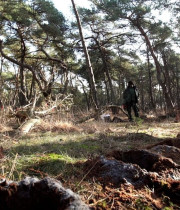Forest soil boost for iconic Dutch national park
Forest soil boost for iconic Dutch national park
Press inquiries
A major trial is underway in De Hoge Veluwe National Park, one of the Netherlands' most iconic nature areas. More than 40,000 trees are being planted, with the aim of restoring the vitality of the forest. The forest soil plays a key role.
Sessile oak, birch, goat willow, common aspen, field maple and hazel: the trees being planted are all 'rich litter' species. They bring up minerals from the subsoil, and release them back into the topsoil when their leaves fall. In this way, they help the forest soil retain moisture and buffer acids.
That's necessary due to ongoing soil acidification, caused by nitrogen precipication among other things. Another challenge is the increasing frequency of drought periods, due to global warming. The trees above ground are directly impacted by this: the soil serves as the foundation - the engine if you like - for everything that grows in it or on it.
(Text continues below the photographs)
Soil transplantation
To give the forest soil a boost, the saplings that are being planted receive different treatments. One is the application of rock dust to mitigate acidity. Another is the 'transplantation' of a thin layer of soil from healthy forest, including its associated soil life.
A handful of soil includes as many as 5000 different species of organisms, and upwards of 10 billion inviduals: from bacteria and fungi to nematodes, springtails and mites. "We collected the material to be transplanted from well-developed forests last week", explains Sam Bielen, who works on the project as PhD candidate supervised by NIOO.
Bielen and the other researchers are hopeful that this form of soil transplantation will 'jumpstart' vital soil cycles, particularly the sequestration of carbon and nitrogen. "We apply one liter of transplanted soil to each tree, forming a little cone. That gives the soil direct access to the roots of the trees, so they can interact right away."
Future proof
The trial has a four-year running period. In total, 43,200 saplings are being planted in 432 fenced plots at eight sites throughout the park. Half those sites have poor soil, the other half have somewhat richer soil. The plots are also divided over sites without any vegetation and sites where there is some Scots pine but with little or no undergrowth.
The different treatments - rock dust and transplanted soil - are applied separately in some plots and combined in other plots, to determine which is most effective and for which tree species. After the four years, the trees will continue to be monitored as they develop - hopefully - into a handsome deciduous forest with a fully restored, healthy soil.
"It takes decades for the trees to grow. In that time, we can learn a lot about what is the best recipe for a climate-smart forest soil!"
Luister naar 'De nacht van...'
De Nacht van KRO-NCRV
Interview over de proef met Annemieke Visser van Het Nationale Park de Hoge Veluwe
Uitzending van NPO Radio 1


Verder lezen
-
Bodemleven onder toekomstbestendige bossenProjectpagina NIOO
-
Zonder gezonde bodem geen gezond bosNieuwsbericht De Hoge Veluwe
Lees ook...
Reportage vanaf de Hoge Veluwe
Waarom planten onderzoekers 42.300 boompjes op De Hoge Veluwe?
Artikel van Omroep Gelderland




